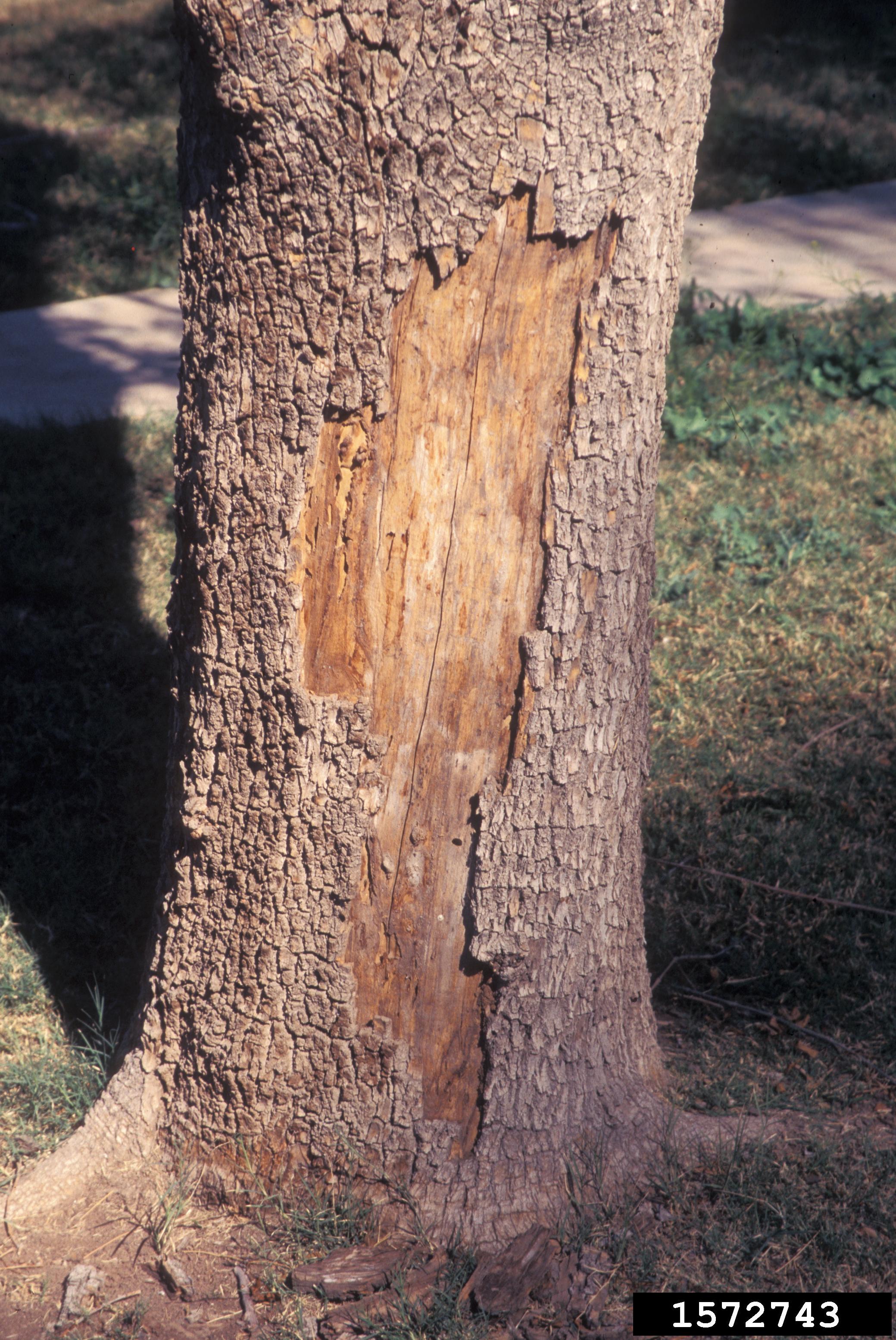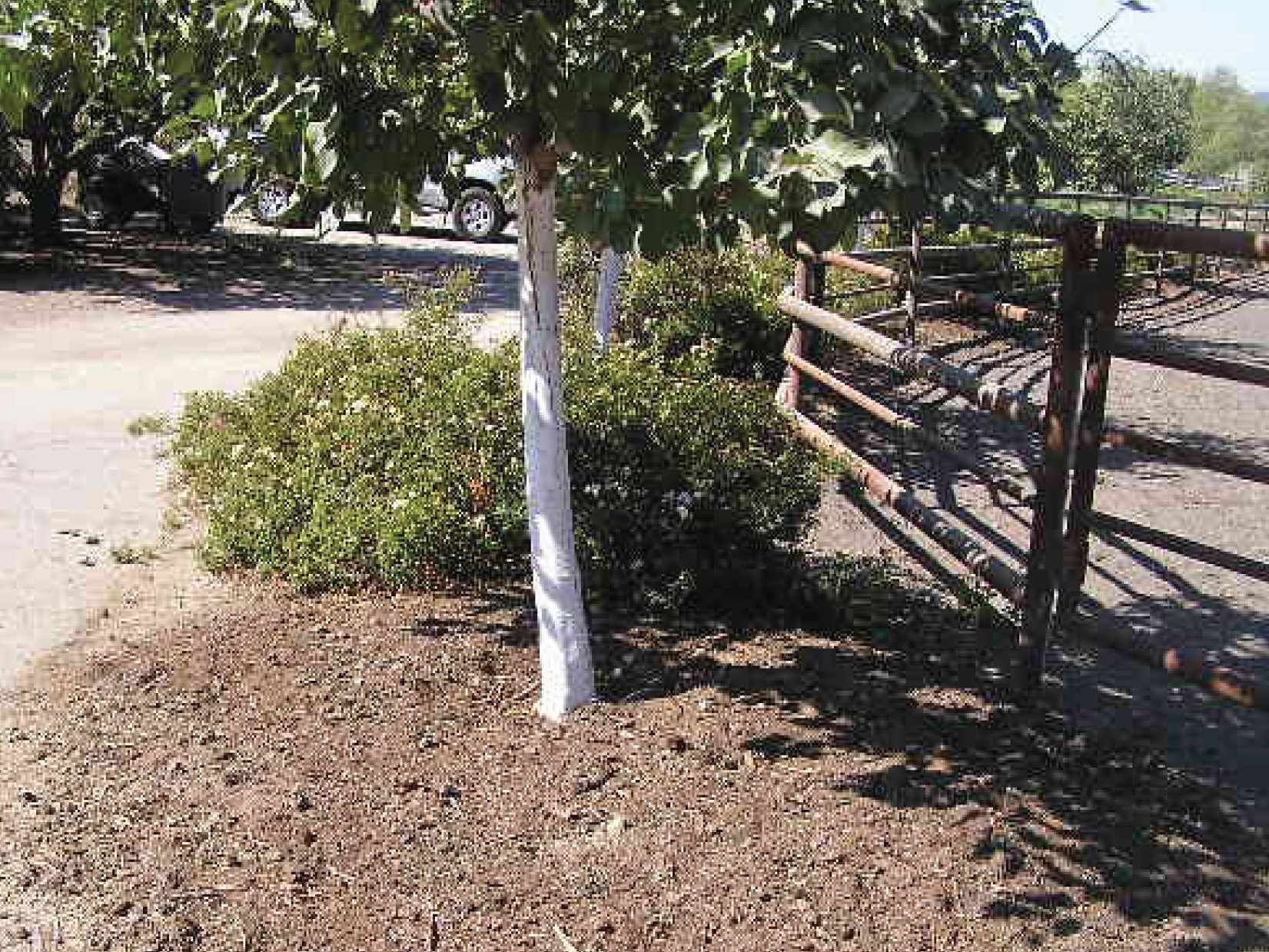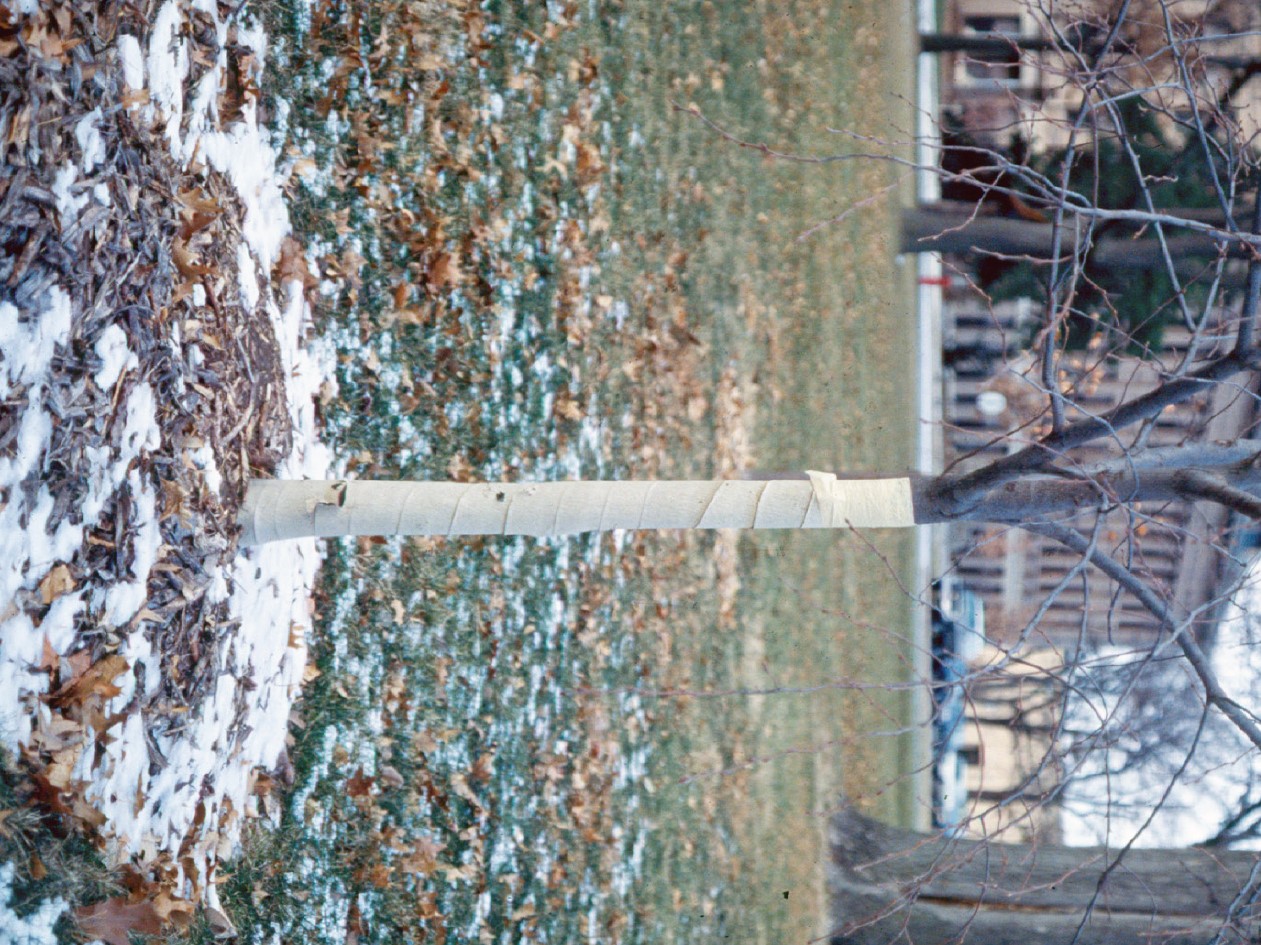 Sunscald and Tree Health - January 6, 2021 Jeff Schalau, Agent, Agriculture & Natural Resources University of Arizona Cooperative Extension, Yavapai County Have you ever seen dead or damaged areas on the trunk of a thin-barked tree? I often in see this in orchards and landscapes that I visit. Sometimes trunk damage is caused by weed eaters, lawn mowers, or wildlife. However, it can also be caused by sunscald. Sunscald (also called “southwest injury”) usually occurs on the south or west side of the tree trunk. Recognizing the causes, symptoms, and taking early corrective actions can help prevent and/or reverse the damage from sunscald. Sunscald is most common on hardwood tree species having thin bark. The damage is caused by large temperature fluctuations during the early spring months. Sunscald can occur when the bark is exposed to warm daytime temperatures followed by freezing temperatures at night. Here, the sensitive cambial cells are killed because they cannot adjust to freezing temperatures that quickly. Sunscald can also result in vertical frost cracks. Frost cracks also provide an entry point for decay and canker pathogens which further damage and weaken the tree. Mild symptoms of sunscald may appear as discolored reddish or brownish bark. More advanced symptoms are sunken and/or split bark which peels back exposing the wood in the trunk. Depending on the extent of the damage and time elapsed since the injury occurred, wood boring beetle larvae may cause additional damage. Reflective surfaces such as light-colored buildings, fences, and block walls can also contribute to sunscald by reflecting additional light and transferring heat during winter days. Over time, sunscald damage can lead to chronic disease and tree death. Young trees are often more susceptible than mature ones due to their thinner bark. It becomes even more of an issue when a young tree is moved from the protected environment of a nursery to the planting site without some gradual hardening-off. Sunscald may also be mistaken for other plant problems or diseases. To properly diagnose sunscald, you should consider contributing factors: recent weather, irrigation method and effectiveness, pruning, planting dates, and potential for root injury. Some trees have naturally exfoliating bark. In our area, these trees include sycamore, Arizona cypress, birch, and some species of pines. To test if damage has occurred, make a small cut into the suspected area with a sharp, clean knife. If the inner bark is soft and green, then it is still alive. If it is brittle and falls off to expose that wood, then damage has occurred. If you still suspect damage but are unsure, evaluate the location of the plant and the potential for direct exposure of the bark to the sun. You can also look for other individuals of the same species in the area to see if they are also affected. The following trees are most susceptible: ash, maple, mimosa, walnut, pecan, and deciduous fruit trees. You may wonder why sunscald is less common in natural areas. Here, trees develop as small shrubs that maintain foliage and branches that shade the trunk. Otherwise, they are shaded by adjacent trees and are not damaged. A major factor causing sunscald of recently planted trees is our tendency to purchase trees that have no lower branches - the lower branches are pruned up to give the tree a more “tree-like” appearance. Where possible, try to purchase young landscape trees that still have a few lower branches. At the very minimum, sunscald reduces growth and slows tree establishment. Once injury occurs, the tree responds by forming callous tissue which slowly grows back over the affected area. This may heal a tree having slight damage, but often, sunscald damage leads to overall decline of the tree. Here are some additional recommendations to minimize sunscald damage. Plant healthy trees which are adapted to your local climate. Avoid excessive pruning of lower branches for a few years after planting. Keep trees adequately irrigated. Paint exposed trunk and limbs with white paint sold for this purpose. Light colored tree wraps can also be used, but can also be hiding places for plant pests. Apply 4-6 inches of coarse organic mulch on the soil surface to retain irrigation water and minimize reflected light and heat. Do not place mulch against the stem. I’ve included additional information below. You can follow the Backyard Gardener on Twitter – use the link on the BYG website. If you have other gardening questions, email the Master Gardener Help Desk in Prescott (prescottmg@gmail.com) or Camp Verde (verdevalleymg@gmail.com) and be sure to include your name, location, and phone number. Find past Backyard Gardener columns or provide feedback at the Backyard Gardener web site: https://cals.arizona.edu/yavapai/anr/hort/byg/. Images  Sunscald on a middle-aged Arizona ash (Fraxinus velutina) tree. This is a common stress injury on Arizona landscape and fruit trees (Gerald Holmes, Strawberry Center, Cal Poly San Luis Obispo, Bugwood.org).
Sunscald on a middle-aged Arizona ash (Fraxinus velutina) tree. This is a common stress injury on Arizona landscape and fruit trees (Gerald Holmes, Strawberry Center, Cal Poly San Luis Obispo, Bugwood.org). Painted tree trunk - use white wash or white tree trunk paint (photo from: Utah State University).
Painted tree trunk - use white wash or white tree trunk paint (photo from: Utah State University). Paper wrapped tree trunk (photo from: Utah State University).
Paper wrapped tree trunk (photo from: Utah State University).Additional Resources Sunscald Injury or Southwest Winter Injury on Deciduous Trees, Utah State University forestry.usu.edu/files/utah-forest-facts/sunscald-injury-or-southwest-winter-injury-on-deciduous-trees.pdf Sunscald of Trees, Colorado State University Extension planttalk.colostate.edu/topics/weeds-cultural-problems/2111-sunscald-trees/ Environmental Injury: Sunscald and Sunburn on Trees, Washington State University Extension pubs.cahnrs.wsu.edu/publications/wp-content/uploads/sites/2/publications/fs197e.pdf |